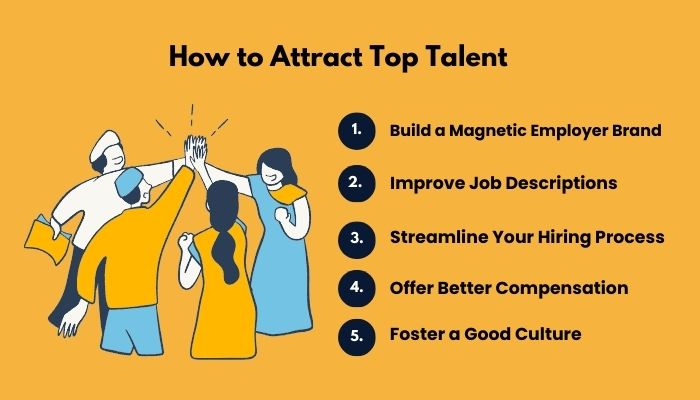
How To Attract Top Talent in a Competitive Job Market
Welcome to the modern recruiting arena, where hiring top talent feels less like staffing a department and more like surviving a corporate version of The Hunger Games. If you’re reading this, you’ve likely realized that finding great people isn’t as simple as posting a job and waiting for unicorns to gallop into your inbox. Sorry to break it to you, but top-tier candidates aren’t refreshing your careers page at 3 AM, hoping today’s the day you finally update that bland job listing from 2016.
If you’re serious about attracting and locking down the best of the best—while your competitors are still busy asking candidates where they see themselves in five years—then it’s time to step up. Let’s dissect exactly how to outwit, outmaneuver, and out-recruit in this relentless talent market. And yes, we’ll sprinkle in some snark to keep you awake.

Outline
1. Build a Magnetic Employer Brand (Or Just Keep Blending In. Your Call.)
Craft a Value Proposition So Good It Hurts
Here’s a brutal truth: nobody cares that you have “competitive pay” and “great benefits.” So does everyone else. If your employer value proposition (EVP) is a soggy sandwich of generic phrases, you’re already losing. Top talent doesn’t just want a job; they want a reason to pick your job over the hundred others flooding their inbox.
What are you offering that’s rare, exciting, and uniquely yours? Is it the opportunity to work on bleeding-edge projects? Unmatched career mobility? A leadership team that actually understands work-life balance? Good. Now stop burying that behind a wall of corporate jargon and make it the headline.
Get Loud (In the Right Places)
If your entire brand visibility strategy is a prayer circle around a LinkedIn post, you’re doing it wrong. High-performing candidates hang out in very specific, often unexpected places—Slack communities, niche forums, exclusive conferences, and professional groups that you’ve never bothered to infiltrate. Start showing up where your talent pool already is.
Sponsor the right events. Get your execs publishing thoughtful, provocative content. Build relationships with industry influencers who can whisper your name into the right ears. And for the love of ROI, invest in employer branding campaigns that reach beyond the career page nobody’s clicking on.
2. Stop Writing Job Descriptions That Sound Like IKEA Manuals
Write Like a Human (Ideally, a Cool One)
Nobody—and I mean nobody—wants to read another job posting that feels like it was assembled from a random buzzword generator. “We’re looking for a detail-oriented, self-starting rockstar ninja with a passion for synergy”? Congratulations, you’ve officially repelled every competent professional who read past the first line. The goal here is clarity and personality.
Describe the work. Explain why it matters. Make the responsibilities sound like something a living, breathing adult would want to spend 40+ hours a week doing. Speak directly to the candidate as if they’re sitting across from you—and for bonus points, don’t make them hate you halfway through the third bullet point.
Define What You Actually Want
Let’s have a quick therapy session. Are you asking for a “unicorn” because you think that’s what it takes, or because you haven’t actually clarified your needs? There’s a difference between ambition and delusion. No, you probably don’t need someone with 12 years of experience in a technology that’s been around for six. Define the must-haves.
Be realistic about what’s trainable versus what’s non-negotiable. Overstuffing your requirements list is a guaranteed way to watch perfect-fit candidates self-select out before you even realize they were there. Narrow your focus and you’ll widen your reach.
3. Streamline Your Hiring Process Before Candidates Die of Old Age
Cut the Bureaucratic Nonsense
If your hiring process requires more checkpoints than airport security, it’s time to face the music: you’re driving away talent. Nothing says “we’re indecisive and disorganized” quite like dragging candidates through six rounds of interviews, a panel presentation, and an essay on why they love Excel. High performers have options, and wasting their time isn’t endearing.
Automate what should be automated. Standardize what can be standardized. Build processes designed to move quickly while still delivering meaningful insights. And if you can’t figure out whether someone is a fit by the third interview, that’s a you problem, not a them problem.
Communicate Like You Care
Candidates don’t ghost themselves. If you’ve got people bailing mid-process or declining offers, chances are your communication strategy is about as warm as a rejection email template. Regular, clear, and personal updates are table stakes. Automations are fine—until they make people feel like they’ve fallen into a black hole of “we’ll get back to you soon” that never ends.
Design your candidate journey like you’re actually trying to impress someone, because you are. And if you wouldn’t tolerate radio silence from a vendor, why are you subjecting your talent pipeline to it?
4. Offer Compensation Packages That Make People Forget About Your Competitors
Money Talks—But Benefits Seal the Deal
Sure, salary matters. No one’s working for exposure. But the reality is that top candidates are evaluating the entire package. Health insurance. Remote flexibility. PTO policies that don’t require an act of Congress to approve. Professional development stipends. Child Care assistance. Retirement contributions. You know, the things that make a job livable.
It’s not enough to match the market anymore; you need to outthink it. Invest in benchmarking data, stay on top of emerging trends, and stop lowballing candidates who can—and will—walk straight into your rival’s open arms.
Tailor to the Talent, Not the Times
The best offers aren’t one-size-fits-all. Some candidates value base pay above all else. Others are chasing equity. Some want a flexible schedule; others crave high-impact projects. If your compensation strategy is rigid, you’re leaving top talent on the table.
Customization isn’t just a nice-to-have; it’s a necessity in a market where candidates expect packages that reflect their unique needs and goals. Flexibility here isn’t a sign of weakness. It’s a demonstration that you know how to play to win.
5. Foster a Culture People Want to Brag About (Without Forcing Them to Post About It on LinkedIn)
Authenticity Over Performative Perks
We get it. You’ve got kombucha on tap and a dog-friendly office. Cool story. But real culture—the kind that keeps top talent engaged—has nothing to do with free snacks and everything to do with how people are treated, supported, and challenged. Are your teams actually collaborating, or just pretending on Slack?
Do your leaders walk the talk, or are they too busy micromanaging from the corner office? Strip away the gimmicks and focus on fostering an environment where people can do the best work of their careers. Trust us, that’s what they’ll brag about.
Invest in Continuous Development
Here’s a secret: high performers hate stagnation. If you’re not actively helping them grow, someone else is. Training budgets, leadership tracks, mentorship programs, conference passes—these aren’t expenses; they’re insurance policies against attrition.
Building a culture of continuous development sends a loud, clear message: we don’t just want you for who you are today. We’re invested in who you’ll become tomorrow. And if you think you can’t afford that? Wait until you see what it costs you when they leave.

